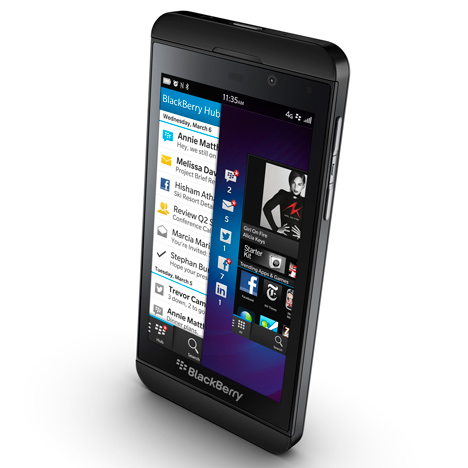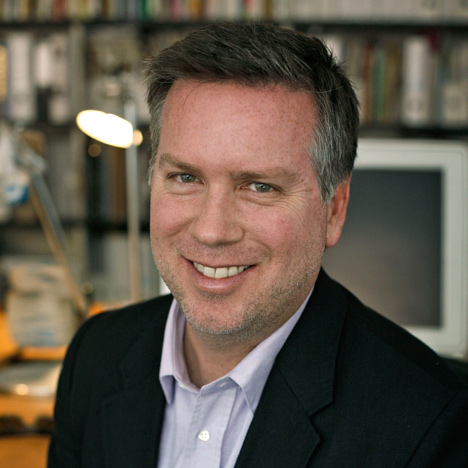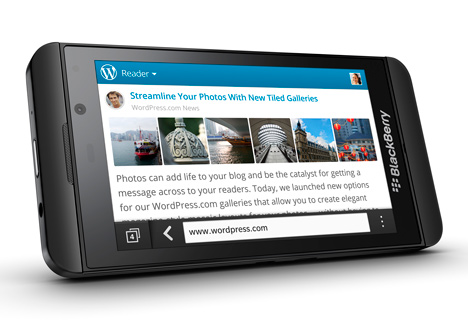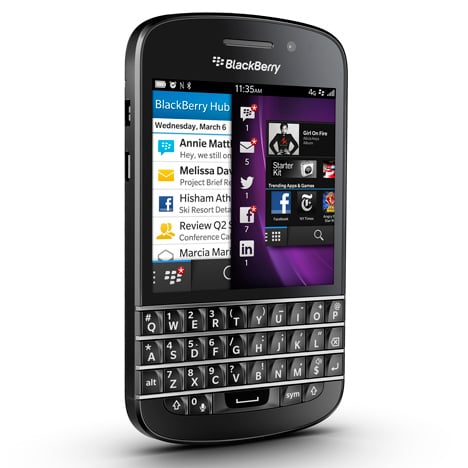
BlackBerry aims to end "hilarious misspelled messages"
Interview: struggling smartphone maker BlackBerry hopes to wrestle back lost market share with a new touchscreen keyboard that will eradicate the "embarrassing" mistakes common on rival smartphones. "Sometimes it's kind of scary when you get your own emails back and you read them," said BlackBerry's head of design Todd Wood.
"Text input is something that we knew a lot about and we thought, let's apply all the intelligence, all the technology we have to make writing and composing and communicating much more efficient and more professional," Wood told Dezeen.
Canadian company Blackberry, which changed its name from Research in Motion at the beginning of the year, is launching two models that use the new BlackBerry 10 operating system – the fully touchscreen Z10 (top and below), available since January, and the forthcoming Q10 (bottom), which has a full QWERTY keyboard as well as a touchscreen.
According to Wood, the new operating system is a response to the growing number of users who had taken to carrying two phones with them – a BlackBerry for business and an iPhone or other touchscreen for personal use. "We solved it with a feature called Balance, where you can easily switch between the environments of business and personal and you can have different apps and different content on both," says Wood.
But for those unwilling to make the switch to a touchscreen device, BlackBerry will still be developing QWERTY phones like the Q10. "As a design we almost own the category," he adds.
Read the full interview below.

Emilie Chalcraft: BlackBerry is launching two phones this year that use its new operating system – the touchscreen Z10 and the touch with keyboard Q10. What do they offer that older models don't?
Todd Wood: These are the first products running on our new operating system, BlackBerry 10. This is something we've created from the ground up. It's built on an operating system that we acquired two years ago called QNX, and it's really suitable for multi-tasking.
We believe it's the future of not only mobile communications, but something we're calling mobile computing. Because you can do virtually any of the multi-tasking apps or services on the go, while you're mobile, and that's quite unique.
All of your communication and social feeds shows up in the hub. You can glance, or "peek" at the hub to see if you have a new message or alert, or you can flow over to other applications like the alarm clock or calendar or maps.
Emilie Chalcraft: BlackBerry is best known for its integration of the full QWERTY keyboard into the phone, so why would you want to move towards a pure touchscreen model like the Z10?
Todd Wood: We have 79 million customers that love their BlackBerrys, and they're primarily keyboard BlackBerrys. These are for people that can type without thinking and love the tactility of the keyboard, and that's great. But we as designers started to notice this phenomenon of people carrying two devices, an all-touch and a BlackBerry – it's often the case of having one business device and one personal device.
So that was one problem we wanted to solve, and we solved it with a feature called Balance, where you can easily switch between the environments of business and personal and you can have different apps and different content on both. Then your business is happy and you're happy, because you have everything you want in one device.
The other problem that we saw that we really wanted to do something about was to do with large displays. They're fantastic for browsing, fantastic for viewing movies, maps and pictures, but the problem with a large display on these touchscreen devices is it's very difficult, and sometimes embarrassing, to type on them.
Emilie Chalcraft: What do you mean by embarrassing?
Todd Wood: We noticed that there are websites that post the most hilarious misspelled messages, and sometimes it's kind of scary when you get your own emails back and you read them. So we realised that's a problem that people have with the accuracy and the efficiency of typing.
Text input is something that we knew a lot about and we thought, let's apply all the intelligence, all the technology we have to make writing and composing and communicating much more efficient and more professional.
The [new] keyboard offers a mode where you can actually have the system suggest words and you can flick these words onto the page, so you don't have to type out frequently used words or names, or long words.

Emilie Chalcraft: But is a full keyboard still more accurate than a touchscreen?
Todd Wood: For some it is, if they're really hard-wired or they have this muscle memory for the keyboard. I've actually been using the Z10 for a number of months and I've become really good at it so I'm willing to switch, but I think that a lot of our customers aren't quite willing to switch, so that's why we've offered the choice.
Emilie Chalcraft: So although it may seem like you’re trying to phase out the keyboard, you're actually retaining that design element because people like it so much?
Todd Wood: Absolutely, it's very iconic. As a design we almost own the category – anything with a QWERTY keyboard, you call it a BlackBerry. But also, what we were excited about was that the engineering can really make something different and better in the world of touch and all-touch devices.
Emilie Chalcraft: The BlackBerry is obviously is a very popular phone for business customers, so are you trying to move away from that customer base with this new touchscreen phone?
Todd Wood: It's really about reframing the problem and realising you can be in an enterprise of one, if you're a freelance journalist or whatever, and you're balancing work and personal.
So we're designing for that person – someone who's hyperconnected, someone who's getting stuff done, and we know that often it's the case of multi-tasking to get things done. And just like we liberated email from the desktop so you're not chained to your desk anymore, in a way we're taking multi-tasking away from the desktop and putting it in your hand.

Emilie Chalcraft: Four or five years ago, BlackBerry was at the top of the market, but since then you've been rapidly overtaken by Apple and then Samsung. How do you propose to compete with those companies?
Todd Wood: Smartphones have become a very big business for our customers and the carriers, and with that big opportunity comes competition. I think the very positive side of all of that is that we're all striving to make things better, so it's really driving innovation in the category.
Through this evolution in the category there are clearly two typologies of devices. There's the one that's most familiar, with the QWERTY keyboard, and that's a category that we own. Then there's the all-touch, which is almost like a Ford or a sedan – just the new normal.
I think then we start to look at the differences between the sedans. There is the brand – and I think you'll see clearly with our product design that it's a BlackBerry – and then it comes down to what makes the user experience better than the other brands, whether it's the applications, like BlackBerry Messenger, whether it's the quality of the display, or just the graphic of the device where we have the distinct edge-to-edge glass.
Emilie Chalcraft: You recently named pop star Alicia Keys as the brand's creative director, but a few weeks ago she was spotted tweeting from her iPhone. Why would a company choose a celebrity as its creative director, especially if they don't have any design training?
Todd Wood: The interesting part in the collaboration with Alicia Keys has to do with our Keep Moving campaign. She is really an iconic personality. She's somebody who is getting things done, working with and using Blackberry as a creative tool and as a communication tool through various applications. She'll be very instrumental further downstream through marketing activities and relationships with the core BlackBerry people in the music industry.
She doesn't have any industrial design background, so it's not clear exactly how we'll work together, but I think that's something to be inspired by and surprised by.
We're a very open brand to collaborations. We've worked with Porsche Design to do a very premium, or "ultra-premium" BlackBerry in the past. They have their own store network where we could experiment with materials that for mass production would be difficult to do – the real leather back, the fully machined seamless frame, etc. So those collaborations are always important.
It's a different way of working. We don't do everything ourselves. We are very open to the developer community, so that could mean being open to brand collaborations, whether it's Alicia Keys or Porsche Design.